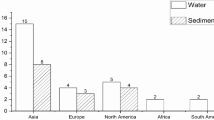Abstract
Pulverized fuel ash (pfa) readily forms pozzolanic aggregates when wetted, and these are common at sites of ash dumping at sea, where they can be up to 2 m across. Field observations on the structure and fauna of aggregates from an ash dumping ground off the Northumberland (UK) coast were undertaken in 1975, together with experimental studies of aggregation, to determine the influence of ash aggregates on the benthic substrate and the faunistic colonisation of aggregates in situ. The aggregates are of a soft sandstone consistency, but are persistent at the sea bed. Particle analysis of aggregates showed negligible contribution by inorganic particles other than the ash, and an overrepresentation of larger diameter particles (3.5 to 4 Φ) compared to pure ash. There was an exponential relationship between aggregation and ash content of experimental sediments. It is suggested that only 15 to 17% of the ash reaching the sea bed will be involved in aggregation. The naturally occurring aggregate fauna consisted of a sparse but diverse sessile epifauna, which depended on encrusting bryozoans for initial colonisation, and a few boring species (Zirfaea crispata, Hiatella arctica, Polydora flava). The presence of 7 yr-old Z. crispata in aggregates confirms their persistence at the sea bed, and indicates that the ash is not toxic.
Similar content being viewed by others
Literature cited
Allen, J. A.: Observations on the size composition and breeding of Northumberland populations of Zirphaea crispata (Pholadidae: Bivalvia). Mar. Biol. 3, 269–275 (1969)
Bamber, R. N.: The effects of dumped pulverised fuel ash on the benthic fauna of the Northumberland Coast, 150 pp. Ph.D. thesis, University of Newcastle-upon-Tyne 1978
Bamber, R. N.: Properties of fly ash as a marine sediment. Mar. Pollut. Bull. 11, 323–326 (1980)
Bamber, R. N.: The benthos of a marine fly ash dumping ground. J. mar. biol. Ass. U.K. (In press) (1983)
Buchanan, J. B.: Measurements of the physical and chemical environment. In: Methods for the study of marine benthos, pp 30–58. Ed. by N. A. Holme and A. D. McIntyre. Oxford: Blackwell Scientific Publications 1971. (IBP Handbook No. 16)
Eggleston, D.: The marine fauna of the Cullercoats district, 3a: Ectoprocta. Rep. Dove mar. Lab. (Ser. 3) 18, 1–30 (1975)
Minnick, L. J., W. C. Webster and E. J. Purdy, Jr.: Prediction of fly ash performance. Inf. Circ. U.S. Bur. Mines 8488, 32–49 (1970)
Rees, C. P.: Sand grain size distribution in tubes of Sabellaria vulgaris Verrill. Chesapeake Sci. 17, 59–61 (1976)
Woodhead, P. M. J., I. W. Duedall and N. F. Lansing: Coal waste artificial reef program, Phase I, 76 pp. New York: New York State Energy Research & Development Authority 1979. (FP-1252 Research Project 1341-1. Interim Rep. prepared for Electric Power Research Institute, Palo Alto)
Author information
Authors and Affiliations
Additional information
Communicated by J. Mauchline, Oban
Rights and permissions
About this article
Cite this article
Bamber, R.N. Pozzolanic aggregates of fly ash in the sea. Mar. Biol. 77, 151–154 (1983). https://doi.org/10.1007/BF00396312
Accepted:
Issue Date:
DOI: https://doi.org/10.1007/BF00396312




